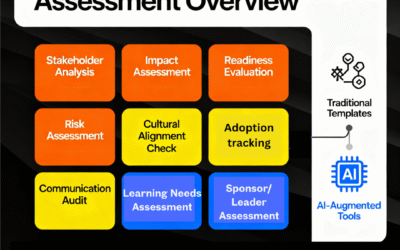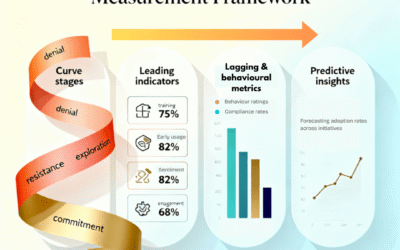Change heatmaps are considered valuable by many organizations struggling with facing too much change. Heatmaps are easy to understand and people intuitively get heatmaps without much explanation. The darker colours are bad, or too much change. The lighter colours are good, less change, or at least this is a common interpretation.
Change heatmaps are commonly used to help decipher whether there is or there is not too much change going on. Stakeholder groups such as the program management office, senior managers, operations managers and other project professionals commonly use the heatmap to show the change ‘heat’ levels of a part of the organization.
So why is this article entitled ‘The death of the change heatmap’?
The problem with most organizations using change heatmaps is that it is often blindly used as a singular discussion point.
A program team would typically review the change heatmap with business stakeholders regarding the current slate of changes. Typical conversations would focus on how many initiatives there are within a given month, and arguments would start around whether it is indeed considered ‘too much change’ or ‘not too much change’. This can become quite rhetorical since it is really anyone’s opinion since this is not a quantitative, numerical discussion.
In this type of discussion, the change manager is often the one raising that there could be too much change going on. A typical response from senior managers would be “Yes there is a lot of change and this is what we need to get on with”. From the senior manager’s perspective, even when presented with a ‘red’ heatmap insinuating too much change, the business is still functioning and has not collapsed. Therefore, the change manager must not be connected to the realities of the business (or at least, what goes through the senior manager’s head).
A discussion focused purely on too much, too little, or just right in the level of change is quite limiting to add value to the business. Are we really only concerned about the magnitude of the change without any other consideration? And how could anyone rely on individual opinions of whether there is or there isn’t too much change when this may not be tied to actual business performance? Most change heat maps are not quantitative summations of change impacts but individual opinions – how might we make this more scientific?
From ‘too much’/’too little’ discussion to story-telling
Change is about design. In planning for change we are designing what the change journey is going to be like. When we have a clear picture of what is going to change, and all the elements around when, where, what, who, how, etc. then we are able to truly paint a picture of what the change experience is going to be.
From this clear picture of the change experience (through having a singular integrated picture of change that is data-based), we are then able to start to tell stories of what will happen and what those experiences might look like.
For example, a story could be that the call centre will be facing significant challenges in balancing both customer call volumes and going through the 12 initiatives during November. Customer call volumes are anticipated to start to trend up, whilst 4 different types of training sessions are expected to take place as a part of the roll out of 4 major initiatives. Those teams supporting Product A will be particularly challenged given 2 of the initiatives impact that team more than other teams. In addition, the desired behaviours being focused by the initiatives are quite different. Some are reinforcing compliance and process adherence, whilst others are about thinking out of the box and experimenting with new ways of working.
You can see from the above example that having a rich set of data about what changes is going to happen can paint a vivid picture of what is going to happen, and therefore emerging challenges and opportunities. The conversations go significant beyond the quantity and judgment of magnitude, through to the type of experiences, possible operational and capacity challenges, behavioural expectations and potential customer impacts.
How might we move on to more valuable discussions beyond the heatmap?
For those who have experienced situations where a heatmap discussion did not lead to any significant business outcomes, what else could we talk about?
- Link heatmap to quantitative business impacts
At a basic level a heatmap can inform stakeholders the foundational picture of how much change if there is direct linkage to time and capacity impacts. For example, given there are 12 initiatives occurring within the call centre in November, how much time is expected to digest and embed this change within that month? 5 hours per week? And would this impact 1,000 call centre staff? Therefore, how does this compare in terms of manpower planning projections in November? Are there challenges to service projected customer call volumes and go through the 5 hours per week required for call centre agents?
To do this we also need to ensure any generated ‘heat level’s are calculated based on actual quantitative change impact levels of each initiative. With historical data on change impacts, it’s also possible and highly impactful to draw correlations between change impact levels and resulting business performance indicators.
- Dive deeper into what is really going on within a particular business.
Instead of focusing on the magnitude of change, zoom in on the specific risks or opportunities. Good questions to ask to paint a story around these include:
- What has this part of the business experienced in the past and how might they perceive this set of changes?
- What types of leadership do we have in this business? What are some of these characteristics? How do these impact how change will be implemented and embedded?
- What support and engagement channels do they have? Do they have change champion networks that can support a multitude of initiatives?
- How has this business been communicated about the myriad set of changes?
- Has there been a clear picture painted by the leaders of where they are going and how these changes will get them closer to their goals?
- How might we better package, sequence or link the set of changes to enhance adoption?
- Show how the strategy is being implemented
A set of strategies will only come to live through successful change implementation. Again, armed with a clear integrated single view of change, you can present a picture of what initiatives are impacting the organization for each of the strategic pillars that the organization has invested in. Particular attention may be drawn to to what extent certain strategic pillars may be making more impacts on the organization at particular points in time.
This is one area in which senior managers will be highly interested. The discussion is not just about operational capacity, but instead moving to the strategic realm to question what the strategic change implementation looks like and how this compares to the intent. Is the set of changes we are planning at the right pace? Or are we not executing fast enough? Is it expected that strategic pillar A exerts more impact in business unit A than B? Or are there gaps in how we’ve designed the overall change journey to realize our objectives? What capabilities may be required for certain lines of business units given the set of changes they will be going through?
So, you can see the change heatmap should absolutely not be the singular focus in understanding multiple changes. If you only focused on the change heatmap with your stakeholders then be prepared for lots of challenges and questions as to the value of this artefact. So, it is not that the change heatmap should not be used or can never add insight. Instead, probe deeper into your data and paint a rich picture of what is going to happen, what this means to the business in tangible terms, and even how the organization’s strategy is being implemented.
For case studies of how some companies have identified risks and opportunities through painting a rich picture of what is going to happen to the business visit here …
Visual images paint a thousand words. If you would like more information on how to visually represent change in all its different facets to tell the full story of what your organization will go through, please trial The Change Compass for free, or drop me a note on [email protected].





